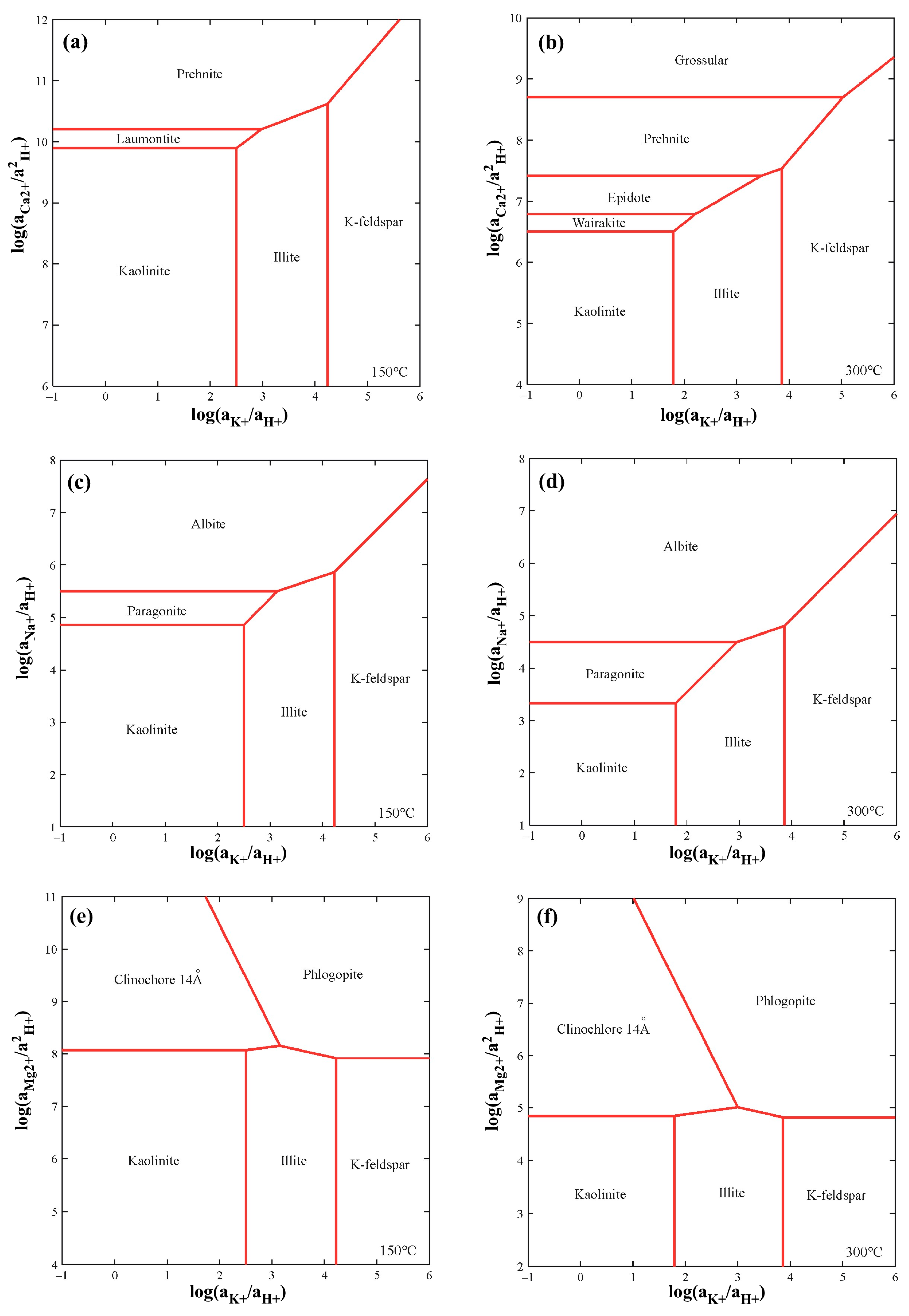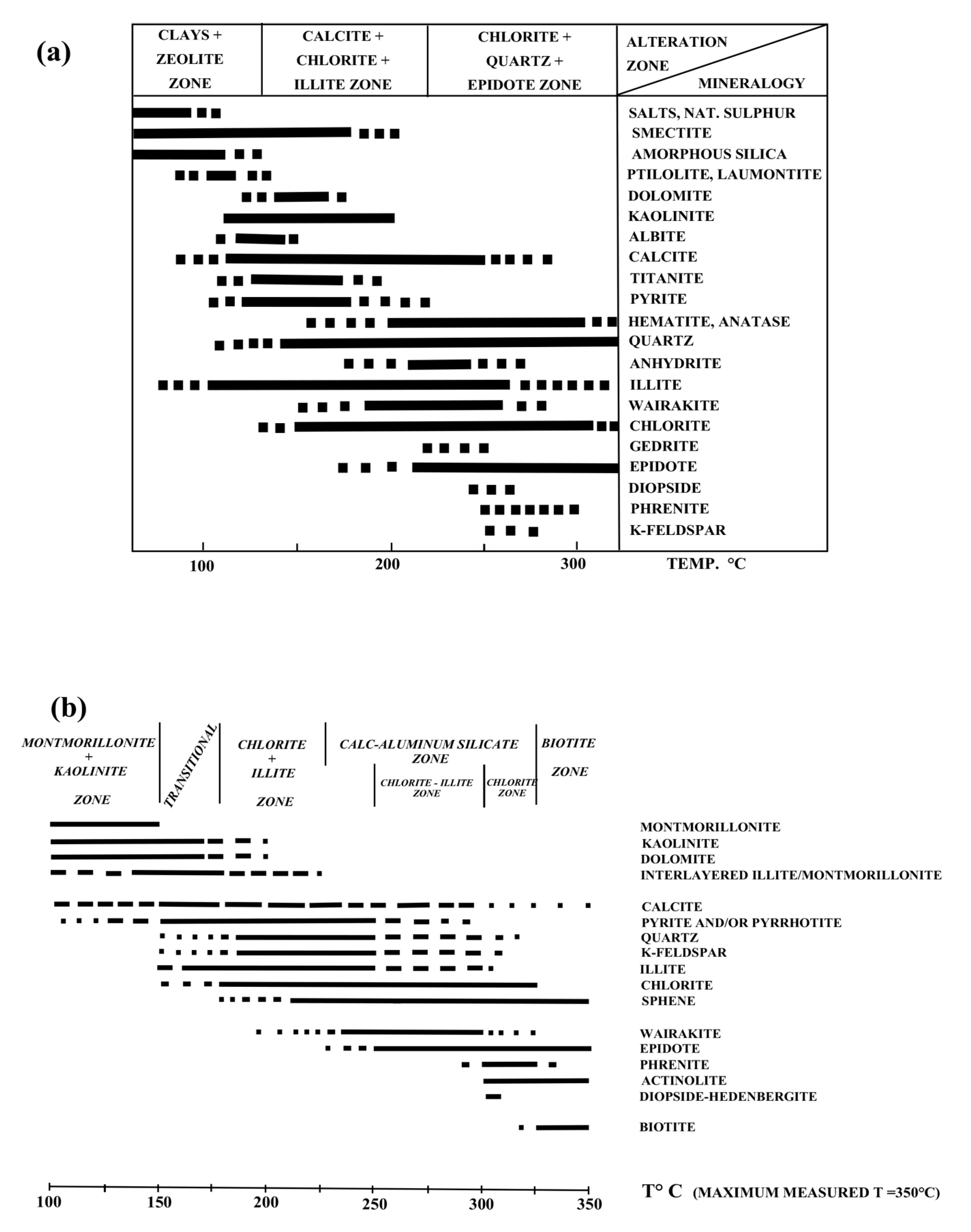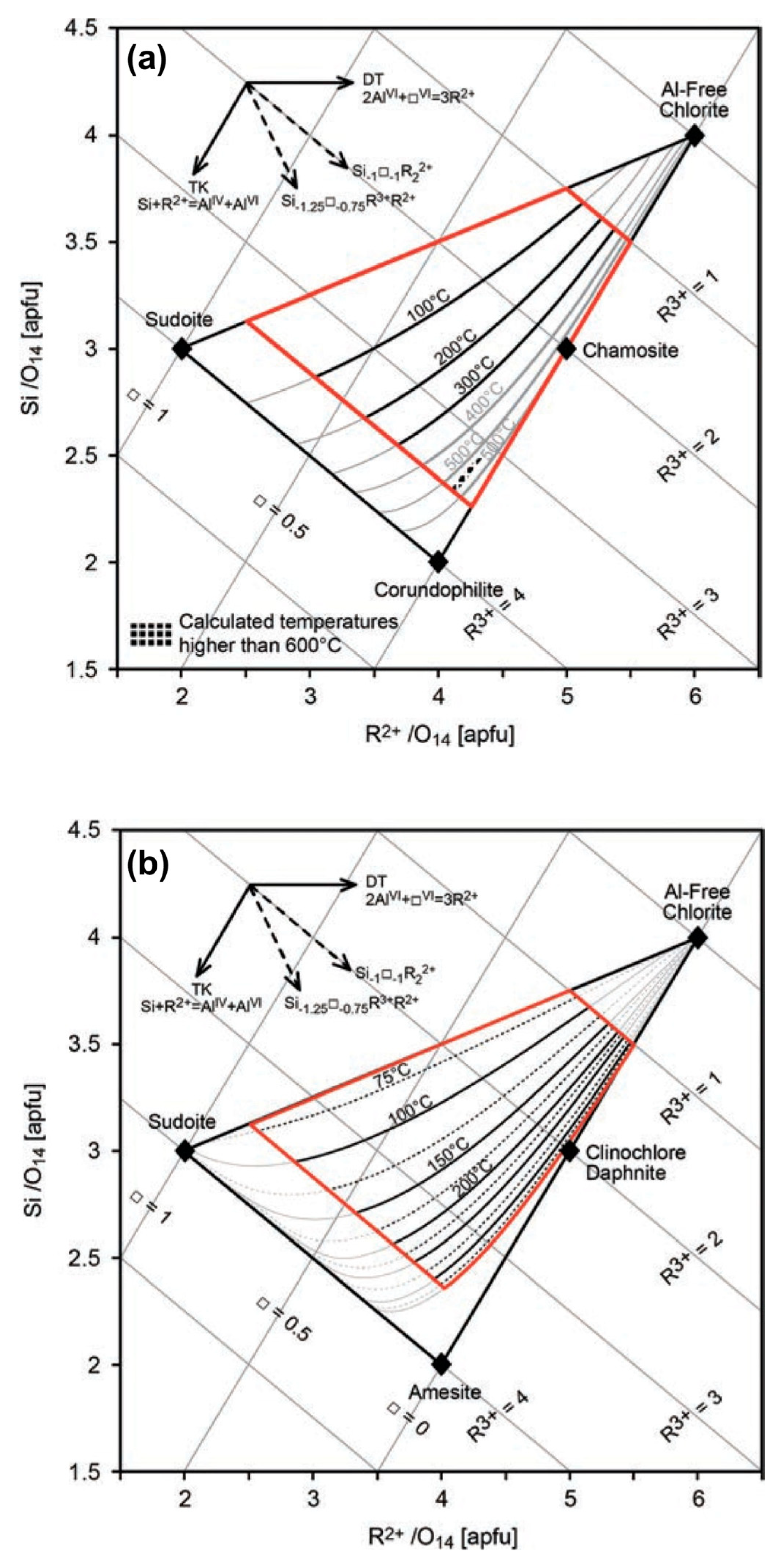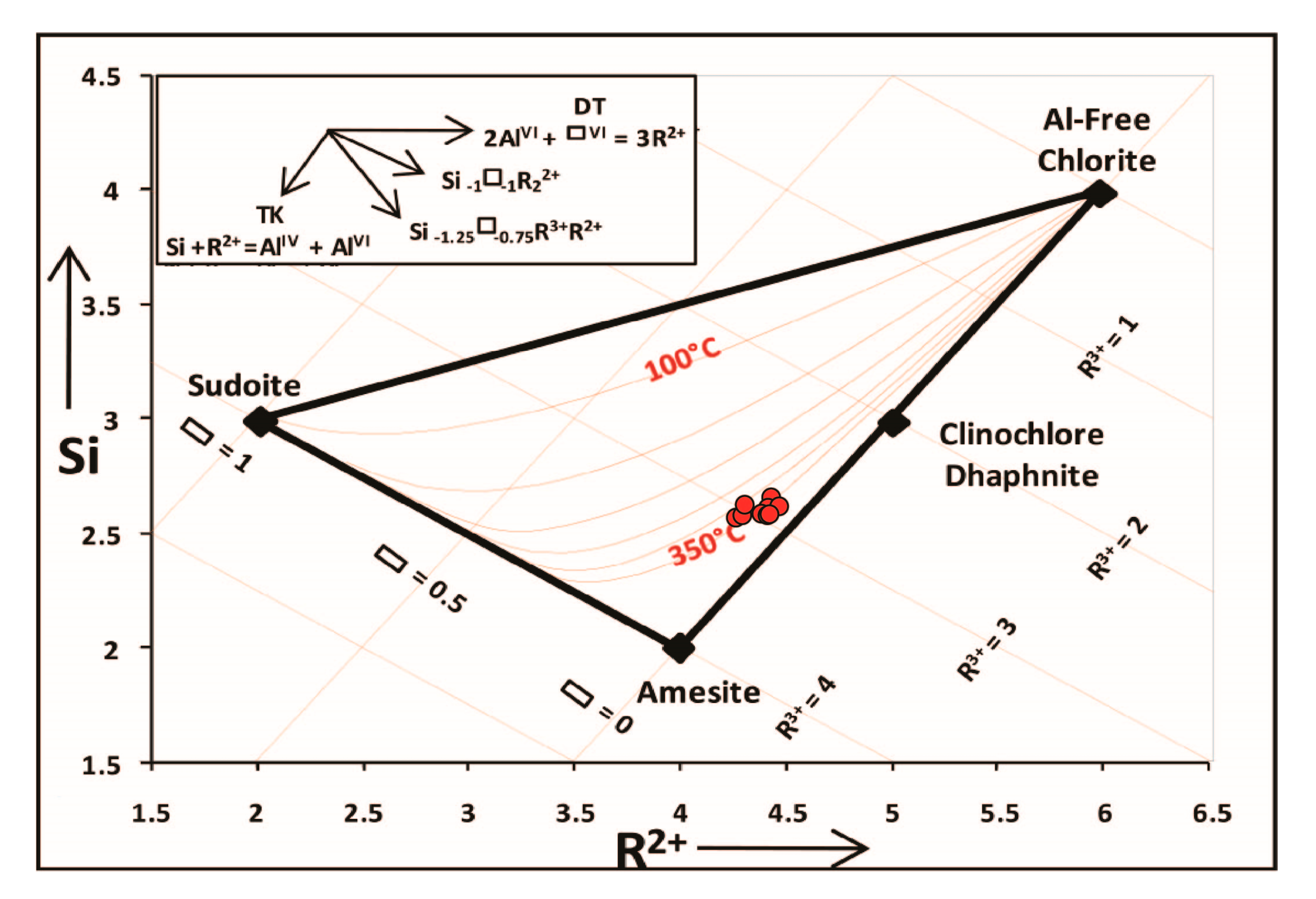Clay Minerals in Hydrothermal Systems
Abstract
1. Introduction
2. Hydrothermal Alteration Paragenesis
3. Main Clay Mineral Groups and Their Significance in Hydrothermal Alteration Paragenesis
3.1. Smectite Group
Albite Na-montmorillonite
3.2. Kaolinite Group
Na-montmorillonite kaolinite
3.3. Pyrophyllite Group
3.4. Illite
3.5. Chlorite
3.6. Biotite
3.7. Talc
3.8. Serpentine Group
3.9. Sepiolite-Palygorskite
3.10. Mixed Layers
3.10.1. Mixed-Layer Chlorite/Smectite (C/S)
3.10.2. Mixed-Layer Illite/Smectite (I/S)
3.10.3. Mixed-Layer Biotite/Vermiculite (B/V)
4. Clay Mineral Geothermometers
4.1. Chlorite Geothermometers
4.2. Illite Geothermometers
5. Stable Isotopes (Oxygen and Hydrogen) of Clay Minerals in Hydrothermal Systems
6. Concluding Remarks
Funding
Acknowledgments
Conflicts of Interest
References
- Pirajno, F. Hydrothermal Mineral Deposits: Principles and Fundamental Concepts for the Exploration Geologist; Springer: Berlin/Heidelberg, Germany, 1992. [Google Scholar]
- Browne, P.R.L. Hydrothermal alteration in active geothermal systems. Ann. Rev. Earth Planet. Sci. 1978, 6, 229–250. [Google Scholar] [CrossRef]
- Browne, P.R.L.; Ellis, A.J. The Ohaki-Broadlands hydrothermal area, New Zeland: Mineralogy and related geochemistry. Am. J. Sci. 1970, 269, 97–131. [Google Scholar] [CrossRef]
- Tomasson, J.; Kristmannsdottir, H. High temperature alteration minerals and thermal brines, Reykjanes, Iceland. Contrib. Mineral. Petrol. 1972, 36, 123–134. [Google Scholar] [CrossRef]
- McDowell, S.D.; Elders, W.A. Authigenic layer silicate minerals in borehole Elmore 1, Salton Sea geothermal field, California, USA. Contrib. Mineral. Petrol. 1980, 74, 293–310. [Google Scholar] [CrossRef]
- Reyes, A.G.; Cardile, C.M. Characterization of clay scales forming in Philippine geothermal wells. Geothermics 1989, 18, 429–446. [Google Scholar] [CrossRef]
- Reyes, A.G. Petrology of Philippine geothermal systems and the application of alteration mineralogy to their assessment. J. Volcanol. Geotherm. Res. 1990, 43, 279–309. [Google Scholar] [CrossRef]
- Flexser, S. Hydrothermal alteration and past and present thermal regimes in the western moat of Long Valley caldera. J. Volcanol. Geotherm. Res. 1991, 48, 303–318. [Google Scholar] [CrossRef]
- Harvey, C.C.; Browne, P.R.L. Mixed-layer clay geothermometry in the Wairakei geothermal field, New Zealand. Clays Clay Miner. 1991, 39, 614–621. [Google Scholar] [CrossRef]
- Schiffman, P.; Fridleifsson, G.O. The smectite-chlorite transition in drillhole NJ-15, Nesjavellir geothermal field, Iceland: XRD, BSE and electron microprobe investigations. J. Metamorph. Geol. 1991, 9, 679–696. [Google Scholar] [CrossRef]
- Inoue, A. Formation of Clay Minerals in Hydrothermal Environments. In Origin and Mineralogy of Clays; Velde, B., Ed.; Springer: Berlin, Geramny, 1995; pp. 268–329. [Google Scholar]
- Patrier, P.; Papapanagiotou, P.; Beaufort, D.; Traineau, M.; Bril, H.; Ross, J. Role of permeability versus temperature in the distribution of the fine (<0.2 pm) clay fraction in the Chipilapa geothermal system (El Salvador, Central America). J. Volcanol. Geotherm. Res. 1996, 12, 101–120. [Google Scholar] [CrossRef]
- Fulignati, P.; Malfitano, G.; Sbrana, A. The Pantelleria caldera geothermal system: Data from the hydrothermal minerals. J. Volcanol. Geotherm. Res. 1997, 75, 251–270. [Google Scholar] [CrossRef]
- Gianelli, G.; Mekuria, N.; Battaglia, S.; Chersicla, A.; Garofalo, P.; Ruggieri, G.; Manganelli, M.; Gebregziabher, Z. Water–rock interaction and hydrothermal mineral equilibria in the Tendaho geothermal system. J. Volcanol. Geotherm. Res. 1998, 86, 253–276. [Google Scholar] [CrossRef]
- Robinson, D.; de Zamora, A.S. The smectite to chlorite transition in the Chipilapa geothermal system, El Salvador. Am. Mineral. 1999, 84, 607–619. [Google Scholar] [CrossRef]
- Mas, A.; Guisseau, D.; Patrier-Mas, P.; Beaufort, D.; Genter, A.; Sanjan, B.; Girard, J.P. Clay minerals related to the hydrothermal activity of the Bouillante geothermal field (Guadeloupe). J. Volcanol. Geotherm. Res. 2006, 158, 380–400. [Google Scholar] [CrossRef]
- Vidal, J.; Patrier, P.; Genter, A.; Beaufort, D.; Dezayes, C.; Glaas, C.; Lerouge, C.; Sanjuan, B. Clay minerals related to the circulation of geothermal fluids in boreholes at Rittershoffen (Alsace, France). J. Volcanol. Geotherm. Res. 2018, 349, 192–204. [Google Scholar] [CrossRef]
- Shau, Y.-H.; Peacor, D.R. Phyllosilicates in hydrothermally altered basalts from DSDP Hole 504B. Leg83-a TEM and AEM study. Contrib. Mineral. Petrol. 1992, 112, 119–133. [Google Scholar] [CrossRef]
- Martinez-Serrano, R.G.; Dubois, M. Chemical variations in chlorite at the Los Humeros geothermal system, Mexico. Clays Clay Miner. 1998, 46, 615–628. [Google Scholar] [CrossRef]
- Cathelineau, M.; Nieva, D. A chlorite solid solution geothermometer The Los Azufres (Mexico) geothermal system. Contrib. Mineral. Petrol. 1985, 91, 235–244. [Google Scholar] [CrossRef]
- Kranidiotis, P.; MacLean, W.H. Systematics of chlorite alteration at the Phelps Dodge massive sulfide deposit, Matagami, Quebec. Econ. Geol. 1987, 82, 1898–1911. [Google Scholar] [CrossRef]
- Walshe, J.L. A six-component chlorite solid solution model and the conditions of chlorite formation in hydrothermal and geothermal systems. Econ. Geol. 1986, 81, 681–703. [Google Scholar] [CrossRef]
- Bishop, B.P.; Bird, D.K. Variation in sericite compositions from fracture zones within the Coso Hot Springs geothermal system. Geochim. Cosmochim. Acta 1987, 51, 1245–1256. [Google Scholar] [CrossRef]
- Cathelineau, M. Cation site occupancy in chlorites and illites as a function of temperature. Clay Miner. 1988, 23, 471–485. [Google Scholar] [CrossRef]
- Jowett, E.C. Fitting iron and magnesium into the hydrothermal chlorite geothermometer. In Proceedings of the GAC/MAC/SEG Joint Annual Meeting, Toronto, ON, Canada, 27–29 May 1991. Program with Abstracts, A62, 16. [Google Scholar]
- de Caritat, P.; Hutcheon, I.; Walshe, J.L. Chlorite geothermometer: A review. Clays Clay Miner. 1993, 41, 219–239. [Google Scholar] [CrossRef]
- Vidal, O.; Parra, T.; Trotet, F. A thermodynamic model for Fe-Mg aluminous chlorite using data from phase equilibrium experiments and natural pelitic assemblages in the 100° to 600 °C, 1–25 kb range. Am. J. Sci. 2001, 301, 557–592. [Google Scholar] [CrossRef]
- Battaglia, S. Variations in the chemical composition of illite from five geothermal fields: A possible geothermometer. Clay Miner. 2004, 39, 501–510. [Google Scholar] [CrossRef]
- Inoue, A.; Meunier, A.; Patrier-Mas, P.; Rigault, C.; Beaufort, D.; Vieillard, P. Application of chemical geothermometry to low-temperature trioctahedral chlorites. Clays Clay Miner. 2009, 57, 371–382. [Google Scholar] [CrossRef]
- Bourdelle, F.; Parra, T.; Chopin, C.; Beyssac, O. A new chlorite geothermometer for diagenetic to low-grade metamorphic conditions. Contrib. Mineral. Petrol. 2013, 165, 723–735. [Google Scholar] [CrossRef]
- Bowers, T.S.; Jackson, K.J.; Helgeson, H.C. Equilibrium Activity Diagrams for Coexisting Minerals and Aqueous Solutions at Pressures and Temperatures to f kb and 600 °C; Springer: Berlin/Heidelberg, Germany; New York, NY, USA, 1984; p. 305. [Google Scholar]
- Henley, R.W.; Truesdell, A.H.; Barton, P.B., Jr. Fluid-Mineral Equilibria in Hydrothermal Systems (Reviews in Economic Geology); Society of Economic Geologists: Littleton, CO, USA, 1984; 267p. [Google Scholar]
- Wood, S.A. Calculation of Activity-Activity and Log fO2-pH Diagrams. Rev. Econ. Geol. 1998, 10, 81–96. [Google Scholar]
- Bethke, C.M. Geochemical and Biogeochemical Reaction Modeling; Cambridge University Press: New York, NY, USA, 2007; 547p. [Google Scholar]
- Cathelineau, M.; Oliver, R.; Garfias, A.; Nieva, O. Mineralogy and distribution of hydrothermal mineral zones in the Los Azufres (Mexico) geothermal field. Geothermics 1985, 14, 49–57. [Google Scholar] [CrossRef]
- Elders, W.A.; Hoagland, J.R.; Williams, A.E. Distribution of hydrothermal mineral zones in the Cerro Prieto geothermal field of Baja California, Mexico. Geothermics 1981, 10, 245–253. [Google Scholar] [CrossRef]
- Papapanagiotou, P.; Patrier, P.; Beaufort, D.; Fouillac, A.-D.; Rojas, J. Occurence of smectites and smectite-rich mixed layers at high temperature within reservoirs of active geothermal fields. In Proceedings of the World Geothermal Congress, Florence, Italy, 18–31 May 1995; pp. 1071–1076. [Google Scholar]
- Ruggieri, G.; Petrone, C.M.; Gianelli, G.; Arias, A.; Henriquez, H.T. Hydrothermal alteration in the Berlin geothermal field (El Salvador): New data and discussion on the natural state of the system. Per. Mineral. 2006, 75, 293–312. [Google Scholar]
- Deer, W.A.; Howie, R.A.; Zussman, J. An Introduction to the Rock-Forming Minerals; Longmans: London, UK, 1966; p. 270. [Google Scholar]
- Stoffregen, R.E.; Alpers, C.N. Woodhouseite and svanbergite in hydrothermal ore deposits: Products of apatite destruction during advanced argillic alteration. Can. Mineral. 1987, 25, 201–211. [Google Scholar]
- Dill, H.G. A geological and mineralogical review of clay mineral deposits and phyllosilicate ore guides in Central Europe—A function of geodynamics and climate change. Ore Geol. Rev. 2020, 119, 103304. [Google Scholar] [CrossRef]
- Dill, H.G.; Fricke, A.; Henning, K.-H.; Theune, C.H. An aluminium-phosphate mineralization from the hypogene La Vanguardia kaolin deposit (Chile). Clay Miner. 1995, 30, 249–256. [Google Scholar] [CrossRef]
- Dill, H.G.; Bosse, H.-R.; Henning, K.-H.; Fricke, A.; Ahrend, H. Mineralogical and chemical variations in hypogene and supergene kaolin deposits in a mobile fold belt—The Central Andes of northwestern Peru. Mineral. Depos. 1997, 32, 149–163. [Google Scholar] [CrossRef]
- Dill, H.G.; Bosse, H.-R.; Kassbohm, J. Mineralogical and chemical studies of volcanic-related argillaceous industrial minerals of the Central American Cordillera (western El Salvador). Econ. Geol. 2000, 95, 517–538. [Google Scholar] [CrossRef]
- Dill, H.G. A comparative study of APS minerals of the Pacific Rim fold belts with special reference to South American argillaceous deposits. J. S. Am. Earth Sci. 2003, 16, 301–320. [Google Scholar] [CrossRef]
- Zhang, S.-Y.; Zhang, H.-F. Genesis of the Baiyun pyrophyllite deposit in the central Taihang Mountain, China: Implications for gold mineralization in wall rocks. Ore Geol. Rev. 2020, 120, 103313. [Google Scholar] [CrossRef]
- Reyes, A.G.; Giggenbach, W.F.; Saleras, J.R.M.; Salonga, N.D.; Vergara, M.C. Petrology and geochemistry of Alto Peak, a vapor-cored hydrothermal system, Leyte Province, Philippines. Geothermics 1993, 22, 479–519. [Google Scholar] [CrossRef]
- Arribas, A., Jr. Characteristics of high-sulfidation epithermal deposits, and their relation to magmatic fluid. Mineral. Assoc. Canada Short Course 1995, 23, 419–454. [Google Scholar]
- Guggenheim, S.; Adams, J.M.; Bain, D.C.; Bergaya, F.; Brigatti, M.F.; Drits, V.A.; Formoso, M.L.L.; Galan, E.; Kogure, T.; Stanjek, H. Summary of recommendations of nomenclature committees relevant to clay mineralogy: Report of the Association Internationale pour l’Etude des Argiles (AIPEA) Nomenclature Committee for 2006. Clay Miner. 2006, 41, 863–877. [Google Scholar] [CrossRef]
- Zang, W.; Fyfe, W.S. Chloritization of the hydrothermally altered bedrock at the Igarapé Bahia gold deposit, Carajás, Brazil. Mineral. Depos. 1995, 30, 30–38. [Google Scholar] [CrossRef]
- Teklemariam, M.; Battaglia, S.; Gianelli, G.; Ruggieri, G. Hydrothermal alteration in the Aluto-Langano geothermal field, Ethiopia. Geothermics 1996, 25, 679–702. [Google Scholar] [CrossRef]
- Boyce, A.J.; Fulignati, P.; Sbrana, A. Deep hydrothermal circulation in a granite intrusion beneath Larderello geothermal area (Italy): Constraints from mineralogy, fluid inclusions and stable isotopes. J. Volcanol. Geotherm. Res. 2003, 126, 243–262. [Google Scholar] [CrossRef]
- Klein, E.L.; Harris, K.; Giret, A.; Moura, C.A.V. The Cipoeiro gold deposit, Gurupi Belt, Brazil: Geology, chlorite geochemistry, and stable isotope study. J. S. Am. Earth Sci. 2007, 23, 242–255. [Google Scholar] [CrossRef]
- Murakami, H. Variations in Chemical Composition of Clay Minerals and Magnetic Susceptibility of Hydrothermally Altered Rocks in the Hishikari Epithermal Gold Deposit, SW Kyushu, Japan. Resour. Geol. 2008, 58, 1–24. [Google Scholar] [CrossRef]
- Sbrana, A.; Fulignati, P.; Marianelli, P.; Boyce, A.J.; Cecchetti, A. Exhumation of an active magmatic–hydrothermal system in a resurgent caldera environment: The example of Ischia (Italy). J. Geol. Soc. Lond. 2009, 166, 1061–1073. [Google Scholar] [CrossRef]
- Inoue, A.; Kurokawa, K.; Hatta, T. Application of chlorite geothermometry to hydrothermal alteration in Toyoha geothermal system, Southwestern Hokkaido, Japan. Resour. Geol. 2010, 60, 52–70. [Google Scholar] [CrossRef]
- Pant, S.; Singh, S.; Sahoo, P.R.; Kumar, A.; Saravanan, B.; Venkatesh, A.S.; Yadav, G.S.; Kumar, P. Mineral chemistry and geothermometry of chlorites in relation to physicochemical conditions of uranium mineralization in the central part of the Singhbhum Shear Zone, eastern India. Ore Geol. Rev. 2019, 112, 102997. [Google Scholar] [CrossRef]
- Chu, G.; Zhang, S.; Zhang, X.; Xiao, B.; Han, J.; Zhang, Y.; Cheng, J.; Feng, Y. Chlorite chemistry of Tongshankou porphyry-related Cu–Mo–W skarn deposit, Eastern China: Implications for hydrothermal fluid evolution and exploration vectoring to concealed orebodies. Ore Geol. Rev. 2020, 122, 103531. [Google Scholar] [CrossRef]
- Pacey, A.; Wilkinson, J.J.; Cooke, D.R. Chlorite and Epidote Mineral Chemistry in Porphyry Ore Systems: A Case Study of the Northparkes District, NSW, Australia. Econ. Geol. 2020, 115, 701–727. [Google Scholar] [CrossRef]
- Jacobs, D.C.; Parry, W.T. A comparison of the geochemistry of biotite from some Basin and Range stocks. Econ. Geol. 1976, 71, 1029–1035. [Google Scholar] [CrossRef]
- Fulignati, P.; Gioncada, A.; Sbrana, A. Hydrothermal alteration in the subsoil of Porto di Levante, Vulcano (Aeolian Islands, Italy). Acta Vulcanol. 1996, 8, 29–138. [Google Scholar]
- Manuella, F.C. Vein mineral assemblage in partially serpentinized peridotite xenoliths from Hyblean Plateau (south-eastern Sicily, Italy). Per. Mineral. 2011, 80, 247–266. [Google Scholar]
- Malvoisin, B.; Brunet, F.; Carlut, J.; Roumejon, S.; Cannat, M. Serpentinization of oceanic peridotites: 2. Kinetics and processes of San Carlos olivine hydrothermal alteration. J. Geophys. Res. 2012, 117, B04102. [Google Scholar] [CrossRef]
- Pozo, M.; Calvo, J.P. An Overview of Authigenic Magnesian Clays. Minerals 2018, 8, 520. [Google Scholar] [CrossRef]
- Srodon, J. Nature of mixed-layer clays and mechanisms of their formation and alteration. Ann. Rev. Earth Planet. Sci. 1999, 27, 19–53. [Google Scholar] [CrossRef]
- Inoue, A.; Utada, M. Smectite-to-chlorite transformation in thermally metamorphosed volcanoclastic rocks in the Kamikita area, northern Honshu, Japan. Am. Mineral. 1991, 76, 628–640. [Google Scholar]
- Schiffman, P.; Staudigel, H. The smectite to chlorite transition in a fossil seamount hydrothermal system: The Basement Complex of La Palma, Canary Islands. J. Metamorph. Geol. 1995, 13, 487–498. [Google Scholar] [CrossRef]
- Meunier, A.; Inoue, A.; Beaufort, D. Chemiographic analysis of trioctahedral smectite-to-chlorite conversion series from the Ohyu caldera, Japan. Clays Clay Miner. 1991, 39, 409–415. [Google Scholar] [CrossRef]
- Buatier, M.D.; Fruh-Green, G.L.; Karpoff, A.M. Mechanisms of Mg-phyllosilicate formation in a hydrothermal system at a sedimented ridge (Middle Valley, Juan de Fuca). Contrib. Mineral. Petrol. 1995, 122, 134–151. [Google Scholar] [CrossRef]
- Bettison-Varga, L.A.; MacKinnon, D.R.; Schiffman, P. Integrated TEM, XRD and electron microprobe investigation of mixed- layer chlorite-smectite from the Point Sal ophiolite, California. J. Metamorph. Geol. 1991, 9, 697–710. [Google Scholar] [CrossRef]
- Robinson, D.; Bevins, R.E.; Rowbotham, G. The characterization of mafic phyllosilicates in low-grade metabasalts from eastern North Greenland. Am. Mineral. 1993, 78, 377–390. [Google Scholar]
- Inoue, A.; Meunier, A.; Beaufort, D. Illite-smectite mixed-layer minerals in felsic voclaniclastic rocks from drill cores, Kakkonda, Japan. Clays Clay Miner. 2004, 52, 66–84. [Google Scholar] [CrossRef]
- Inoue, A.; Lanson, B.; Marques-Fernandes, M.; Sakharov, B.A.; Murakami, T.; Meunier, A.; Beaufort, D. Illite-smectite mixed-layer minerals in the hydrothermal alteration of volcanic rocks: I. one-dimensional XRD structure analysis and characterization of component layers. Clays Clay Miner. 2005, 53, 423–439. [Google Scholar] [CrossRef]
- Murakami, T.; Inoue, A.; Lanson, B.; Meunier, A.; Beaufort, D. Illite-smectite mixed-layer minerals in hydrothermal alteration of volcanic rocks: II. One-dimensional HRTEM structure-images and formation mechanism. Clays Clay Miner. 2005, 53, 440–451. [Google Scholar] [CrossRef]
- Vidal, O.; Parra, T.; Vieillard, P. Thermodynamic properties of the Tschermak solid solution in Fe-chlorite: Application to natural examples and possible role of oxidation. Am. Mineral. 2005, 90, 347–358. [Google Scholar] [CrossRef]
- Vidal, O.; De Andrade, V.; Lewin, E.; Munoz, M.; Parra, T.; Pascarelli, S. P-T-deformation-Fe3+/Fe2+ mapping at the thin section scale and comparison with XANES mapping: Application to a garnet-bearing metapelite from the Sambagawa metamorphic belt (Japan). J. Metamorph. Geol. 2006, 24, 669–683. [Google Scholar] [CrossRef]
- Bourdelle, F.; Cathelineau, M. Low-temperature chlorite geothermometry: A graphical representation based on a T–R2+–Si diagram. Eur. J. Mineral. 2015, 27, 617–626. [Google Scholar] [CrossRef]
- Wiewiora, A.; Weiss, Z. Crystallochemical classifications of phyllosilicates based on the unified system of projection of chemical composition: II The chlorite group. Clay Miner. 1990, 25, 83–92. [Google Scholar] [CrossRef]
- Campbell, A.R.; Larson, P.B. Introduction to stable isotope applications in hydrothermal systems. Rev. Econ. Geol. 1998, 10, 173–193. [Google Scholar]
- Hedenquist, J.W.; Arribas Jr, A.; Reynolds, T.J. Evolution of an intrusion-centered hydrothermal system: Far Southeast-Lepanto porphyry and epithermal Cu-Au deposits, Philippines. Econ. Geol. 1998, 93, 373–404. [Google Scholar] [CrossRef]
- Pacey, A.; Wilkinson, J.J.; Boyce, A.J.; Millar, I.L. Magmatic fluids implicated in the formation of propylitic alteration: Oxygen, hydrogen, and strontium isotope constraints from the Northparkes porphyry Cu-Au District, New South Wales, Australia. Econ. Geol. 2020, 115, 729–748. [Google Scholar] [CrossRef]
- Truesdell, A.H. Oxygen isotope activities and concentrations in aqueous salt solutions at elevated temperatures: Consequences for isotope geochemistry. Earth Planet. Sci. Lett. 1974, 23, 387–396. [Google Scholar] [CrossRef]
- Graham, C.M.; Sheppard, S.M.F. Experimental hydrogen isotope studies, II. Fractionations in the systems epidote-NaCl-H2O, epidote-CaC12-H2O and epidote-seawater, and the hydrogen isotope composition of natural epidotes. Earth Planet. Sci. Lett. 1980, 49, 237–251. [Google Scholar] [CrossRef]
- Horita, J.; Cole, D.R.; Wesolowski, D.J. The activity-composition relationship of oxygen and hydrogen isotopes in aqueous salt solutions: II. Vapor-liquid water equilibration of mixed salt solutions from 50 to 100~ and geochemical implications. Geochim. Cosmochim. Acta 1993, 57, 4703–4711. [Google Scholar] [CrossRef]
- Sheppard, S.M.F.; Gilg, H.A. Stable isotope geochemistry of clay minerals. Clay Miner. 1996, 31, 1–24. [Google Scholar] [CrossRef]
- Zheng, Y.-F. Calculation of oxygen isotope fractionation in hydroxyl-bearing silicates. Earth Planet. Sci. Lett. 1993, 120, 247–263. [Google Scholar] [CrossRef]
- Cole, D.R.; Ripley, E.M. Oxygen isotope fractionation between chlorite and water from 170 to 350 °C: A preliminary assessment based on partial exchange and fluid/rock experiments. Geochim. Cosmochim. Acta 1998, 63, 449–457. [Google Scholar] [CrossRef]
- Saccocia, P.J.; Seewald, J.S.; Shanks, W.C., III. Oxygen and hydrogen isotope fractionation in serpentine-water and talc-water systems from 250 to 450 °C, 50 MPa. Geochim. Cosmochim. Acta 2009, 76, 6789–6804. [Google Scholar] [CrossRef]
- Gilg, H.A.; Sheppard, S.M.F. Hydrogen isotope fractionation between kaolinite and water revisited. Geochim. Cosmochim. Acta 1996, 60, 529–533. [Google Scholar] [CrossRef]
- Suzuoki, T.; Epstein, S. Hydrogen isotope fractionation between OH-bearing minerals and water. Geochim. Cosmochim. Acta 1976, 40, 1229–1240. [Google Scholar] [CrossRef]
- Graham, C.M.; Viglino, J.A.; Harmon, R.S. Experimental study of hydrogen-isotope exchange between aluminous chlorite and water and of hydrogen diffusion in chlorite. Am. Mineral. 1987, 72, 566–579. [Google Scholar]




| Hydrothermal Alteration Facies | pH | Temperature |
|---|---|---|
| Argillic | 5.5–7 | <160 °C |
| Intermediate argillic | 4–5.5 | <160 °C |
| Advanced argillic | 2–4 | <160–300 °C |
| Phyllic | 5.5–7 | 160–230 °C |
| Propylitic | 5.5–7 | 230–350 °C |
| Alkali metasomatism | 5.5–7 | >350 °C |
| Clay Minerals | Associated Minerals | Hydrothermal Alteration Facies | pH | Temperature |
|---|---|---|---|---|
| Dioctahedral smectites | Zeolite group | Argillic | 5.5–7 | <160 °C |
| Trioctahedral smecitites * | Zeolite group | Argillic | 5.5–7 | <160 °C ** |
| Sepiolite-palygorskite | di-trioctahedral smectites | Argillic | 5.5–8 | <160 °C |
| Kaoline group | ±smectites | Intermediate argillic | 4.5–6 | <200 °C |
| ±alunite | ||||
| Pyrophyllite | alunite | High-T advanced argillic | 2–4 | 200–300 °C |
| Mixed layers I/S | Mixed layers C/S ± illite | Phyllic | 5.5–7 | 150–220 °C |
| Mixed layers C/S | Mixed layers I/S ± illite | Phyllic | 5.5–7 | 160–250 °C |
| Illite | chlorite, adularia, albite, epidote, quartz ± biotite ± garnet ± amphibole | Propylitic | 5.5–7 | 220–350 °C |
| Chlorite | chlorite, adularia, albite, epidote, quartz ± biotite ± garnet ± amphibole | Propylitic | 5.5–7 | 220–350 °C |
| Talc | chlorite, illite, adularia, albite, epidote, quartz | Propylitic | 5.5–7 | 250–300 °C |
| Serpentine group | chlorite, talc | Propylitic | 5.5–7 | 250–350 °C |
| Mixed layers B/V | chlorite, illite, adularia, albite, epidote, quartz | Propylitic | 5.5–7 | 250–320 °C |
| Biotite | K-feldspar ± garnet ± amphibole ± clinopyroxene | Alkali metasomatism | 5.5–7 | >320 °C |
Publisher’s Note: MDPI stays neutral with regard to jurisdictional claims in published maps and institutional affiliations. |
© 2020 by the author. Licensee MDPI, Basel, Switzerland. This article is an open access article distributed under the terms and conditions of the Creative Commons Attribution (CC BY) license (http://creativecommons.org/licenses/by/4.0/).
Share and Cite
Fulignati, P. Clay Minerals in Hydrothermal Systems. Minerals 2020, 10, 919. https://doi.org/10.3390/min10100919
Fulignati P. Clay Minerals in Hydrothermal Systems. Minerals. 2020; 10(10):919. https://doi.org/10.3390/min10100919
Chicago/Turabian StyleFulignati, Paolo. 2020. "Clay Minerals in Hydrothermal Systems" Minerals 10, no. 10: 919. https://doi.org/10.3390/min10100919
APA StyleFulignati, P. (2020). Clay Minerals in Hydrothermal Systems. Minerals, 10(10), 919. https://doi.org/10.3390/min10100919





